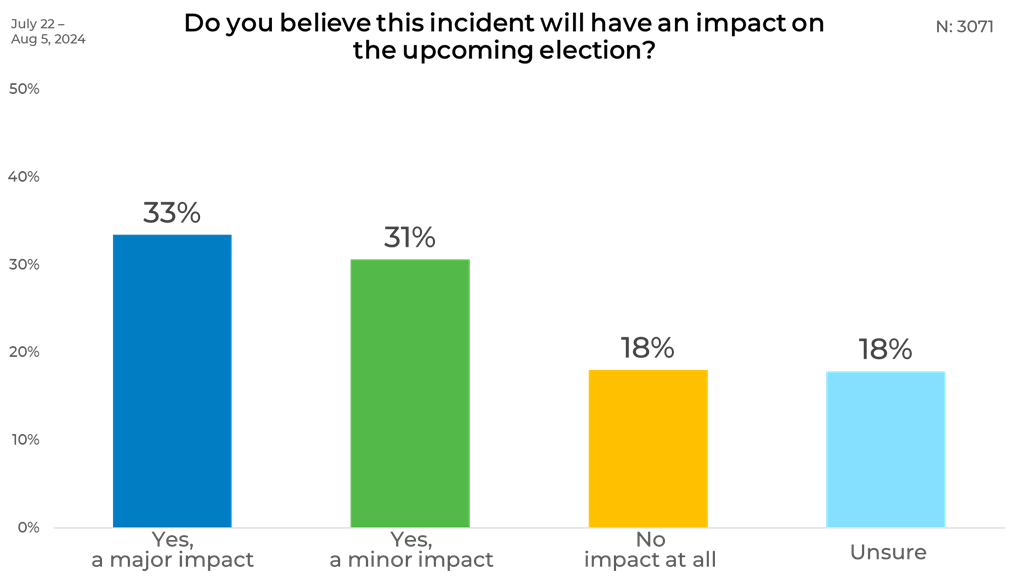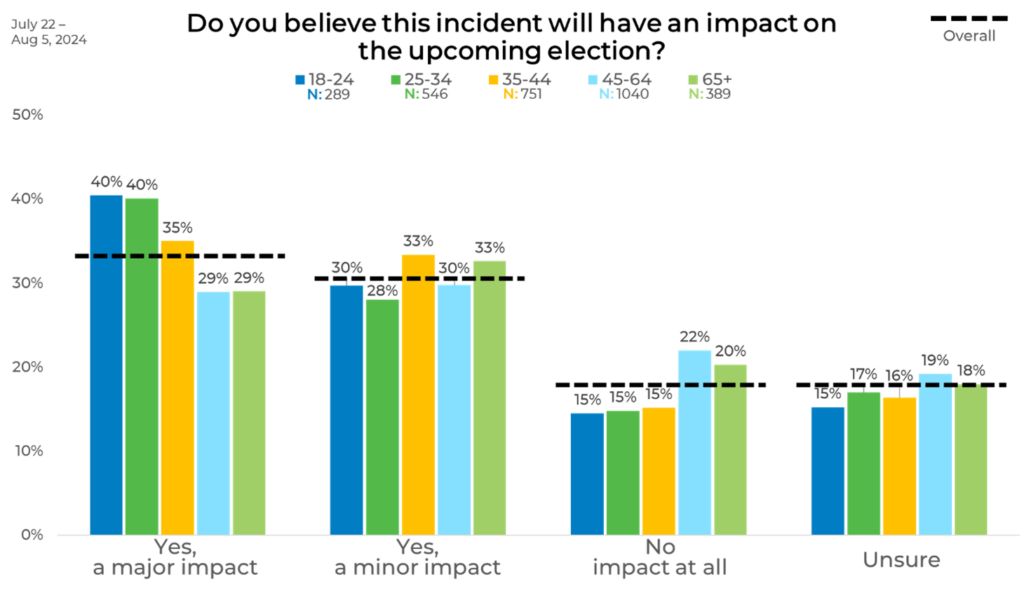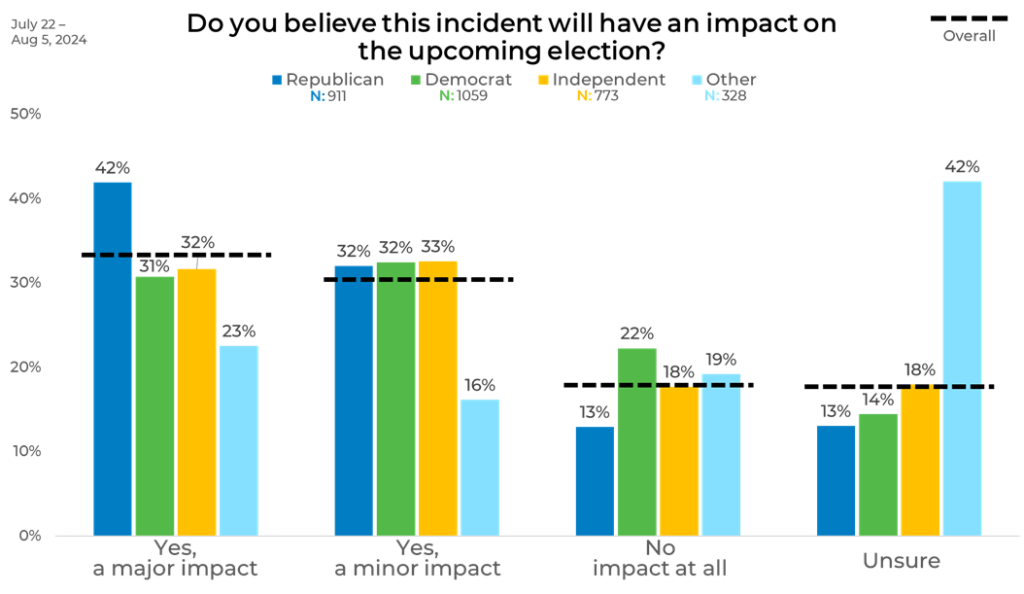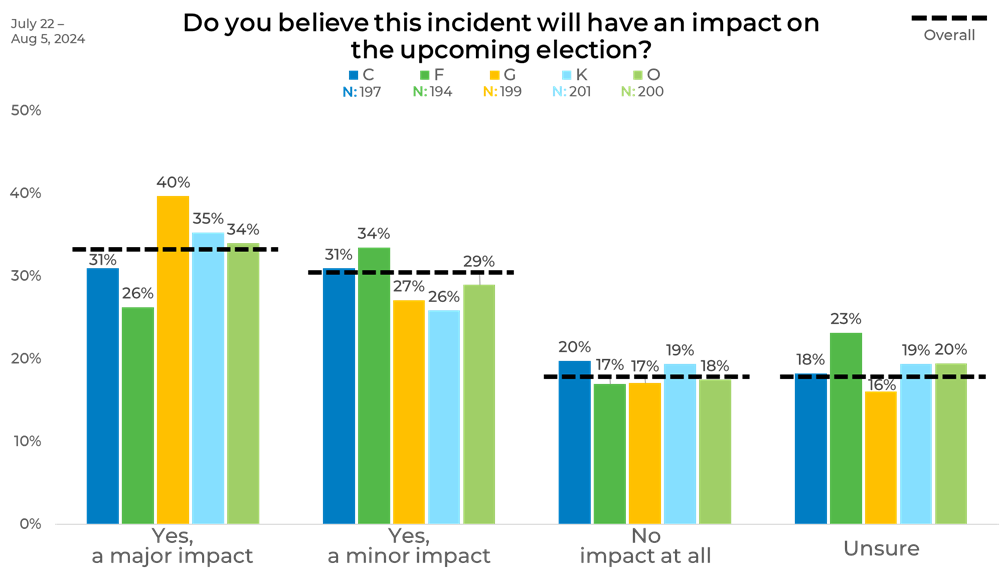
News That’s Making Waves in the MR Industry
August 12, 2024Shifting Perceptions: The Trump Assassination Attempt and Public Opinion
August 20, 2024Public opinion on the recent assassination attempt on Trump is deeply divided, reflecting the complexity of the political landscape. While some predict a significant impact on the upcoming election, others are less certain about its influence. Let’s dive into the details to see how different groups perceive the potential consequences.
General
The data shows that public opinion is quite divided on the potential impact of the recent assassination attempt on Trump. A combined 64% of respondents believe it will have an impact, with 33% expecting a major impact and 31% foreseeing a minor one. Meanwhile, 18% of respondents think there will be no impact at all, and an equal 18% are unsure about the incident's influence on the election. This indicates a significant portion of the population anticipates some level of effect, although opinions on the extent vary.

Age
The age breakdown shows younger respondents (18-24 and 25-34) are more likely to believe the incident will have a major impact, both at 40%. This belief declines with age, with only 29% of those 45-64 and 65+ seeing a major impact. Minor impact perceptions peak among the 35-44 and 65+ groups at 33%, with the other age groups slightly lower. Belief in no impact at all increases with age, from 15% among the youngest groups to 22% in the 45-64 group and 20% among those 65+. Uncertainty is fairly even across age groups, ranging from 15% to 19%. This suggests that while younger people are more likely to predict a significant impact, older respondents are more skeptical, reflecting a varied outlook on the incident's potential effect on the election across different age groups.

Gender
The age breakdown shows younger respondents (18-24 and 25-34) are more likely to believe the incident will have a major impact, both at 40%. This belief declines with age, with only 29% of those 45-64 and 65+ seeing a major impact. Minor impact perceptions peak among the 35-44 and 65+ groups at 33%, with the other age groups slightly lower. Belief in no impact at all increases with age, from 15% among the youngest groups to 22% in the 45-64 group and 20% among those 65+. Uncertainty is fairly even across age groups, ranging from 15% to 19%. This suggests that while younger people are more likely to predict a significant impact, older respondents are more skeptical, reflecting a varied outlook on the incident's potential effect on the election across different age groups.

Political Affiliation
The political breakdown reveals distinct variations in perceptions. Republicans are the most likely to predict a major impact (42%), compared to Democrats (31%), Independents (32%), and those identifying as Other (23%). When considering a minor impact, Democrats and Independents are nearly identical at 32% and 33% respectively, while Republicans follow closely at 32%. Notably, Democrats (22%) are more inclined to believe there will be no impact, with Republicans at 13% and Independents at 18%. A significant divergence appears in the uncertainty category, where 42% of respondents identifying as Other are unsure, compared to much lower percentages among Republicans (13%), Democrats (14%), and Independents (18%).

Panel
The panel breakdown reveals notable differences in perceptions. Panel G has the highest percentage of respondents anticipating a major impact (40%), followed by Panel K (35%) and Panel O (34%). Panel C and Panel F are lower, at 31% and 26%, respectively. Minor impact expectations are highest in Panel F (34%), with Panel C following closely at 31%. Panels G, K, and O are lower, ranging from 26% to 29%. Belief in no impact at all is fairly consistent across panels, hovering between 17% and 20%. Uncertainty is most pronounced in Panel F (23%), while the other panels show slightly lower but comparable levels of uncertainty, between 16% and 20%. This highlights that Panel G stands out with the highest expectation of a major impact, whereas Panel F is more inclined towards predicting a minor impact and shows the highest uncertainty.

This is an excellent representation of where quality data sampling matters. At EMI, we prioritize strategically blending sample sources to balance demographics as well as behaviors and attitudes to ensure that we provide the most representative and accurate data. Download The Sample Landscape: 2024 Edition to better understand how panels differ from one another and how they impact your data.



